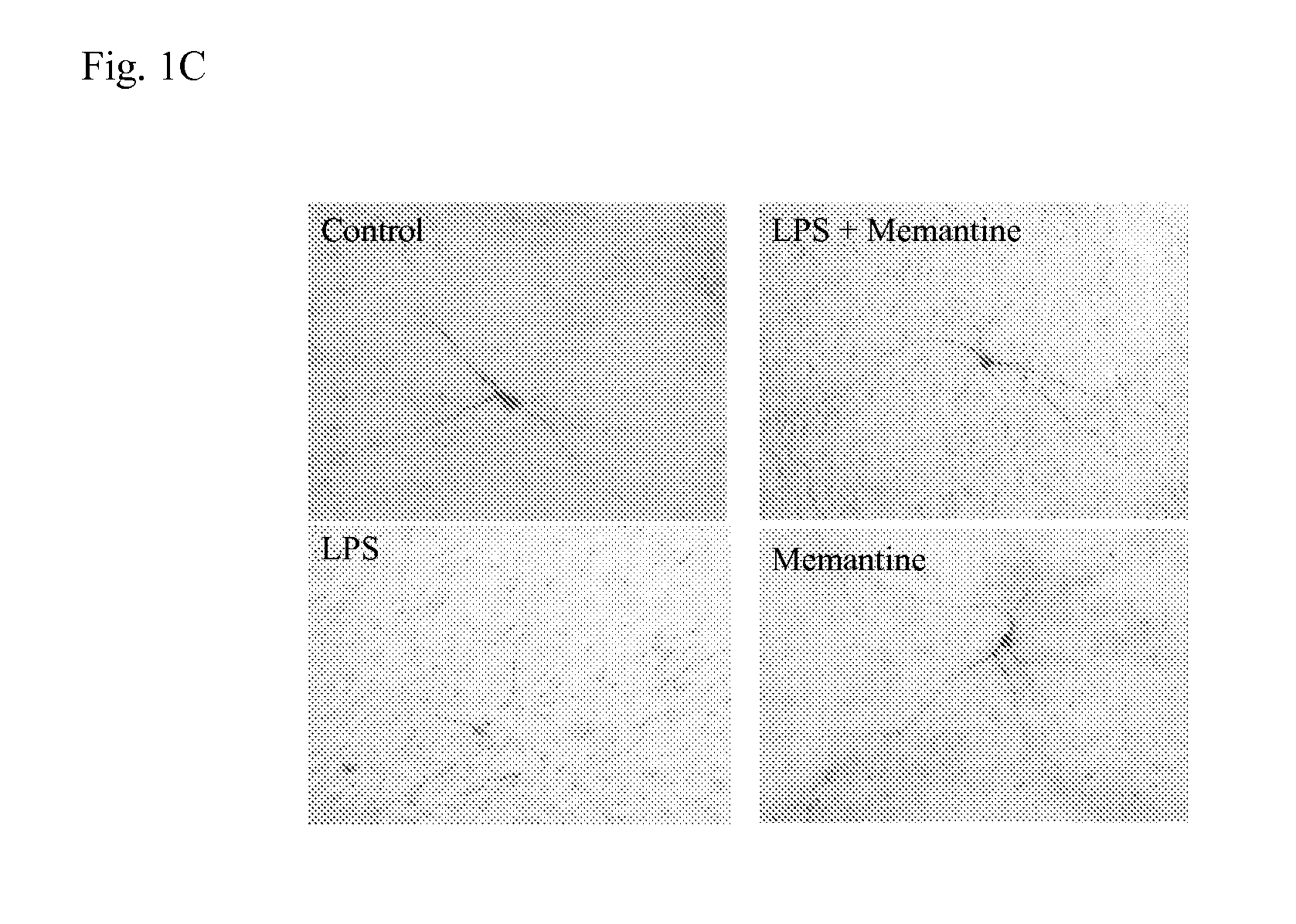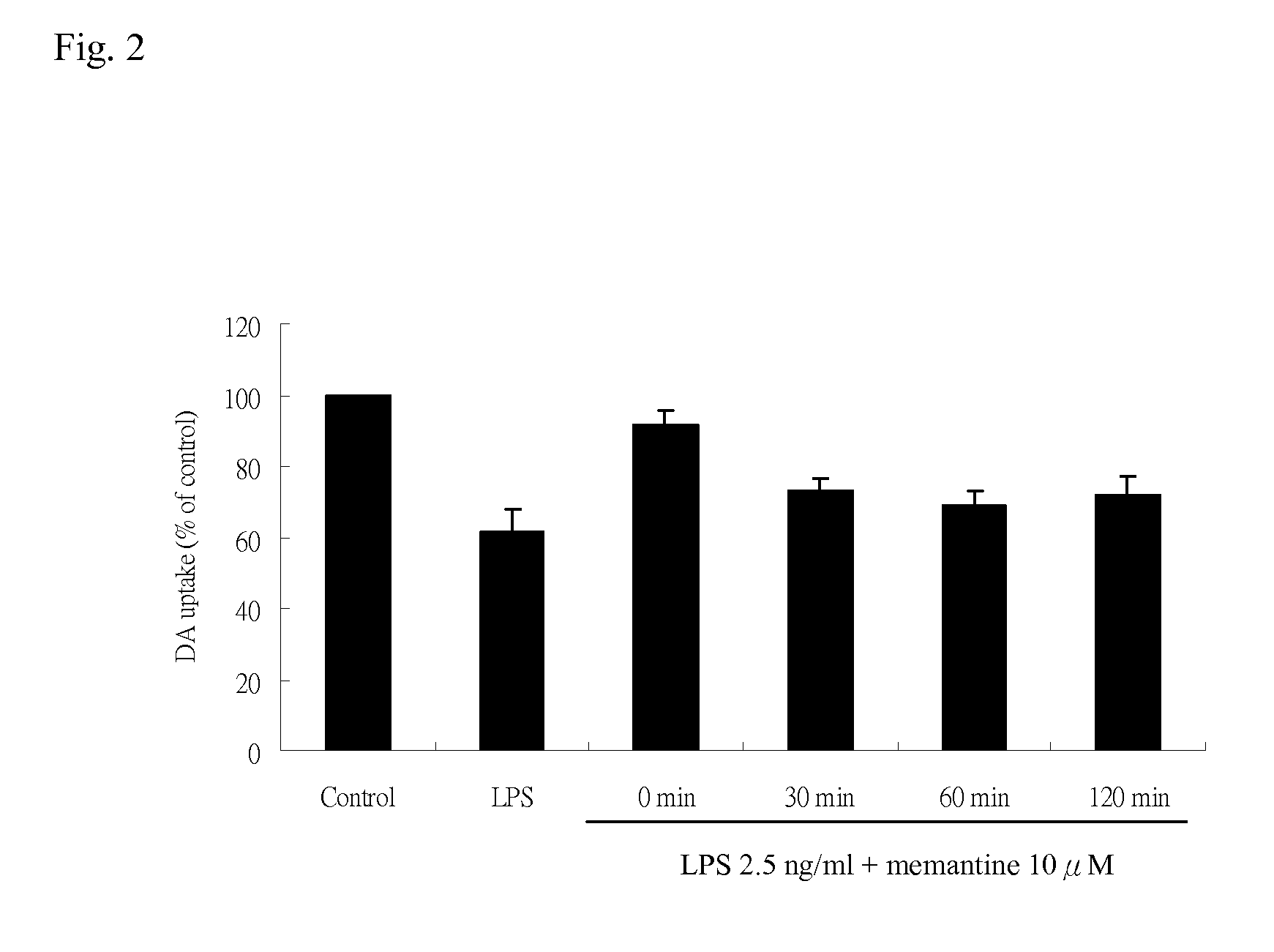Memantine Protects Inflammation-Related Degeneration of Dopamine Neurons Through Inhibition of Over-Activated Microglia and Release of Neurotrophic Factors From Astroglia
a technology of nmethyldaspartate and dopamine, which is applied in the direction of biocide, animal husbandry, organic active ingredients, etc., can solve the problems of inability to modify the disease course and limited effective therapies
- Summary
- Abstract
- Description
- Claims
- Application Information
AI Technical Summary
Benefits of technology
Problems solved by technology
Method used
Image
Examples
example 1
Uptake Assays and Cell Counting
[0072]1. [3H] DA Uptake Uptake Assays
[0073]Cells were incubated in Krebs-Ringer buffer (16 mM NaH2PO4, 1.2 mM MgSO4, 1.3 mM EDTA, 4.7 nM KCL, for 21 min at 37° C. with 1 μM [3H] DA. Nonspecific uptake was blocked for DA with 10 μM mazindole. After incubation, cells were washed three times with 1 mL / well of ice-cold Krebs-Ringer buffer. Cells were then lysed with 0.5 mL / well of 1 N NaOH and mixed with 15 mL of scintillation fluid. Radioactivity was measured on a scintillation counter, where specific [3H] DA uptake was calculated by subtracting the mazindole.
[0074]2. Cell Counting
[0075]For visual counting of TH-ir neurons after Immunostaining, nine representative areas per well of the 24-well plate were counted under the microscope at 100¥ magnification. To measure the average TH-ir dendrite, 50 TH-ir representative neurons in each well were selected and three wells for each treatment condition were selected. In addition, the average dendrite length of T...
example 2
Immunostaining, Superoxide, Intracellular Reactive Oxygen Species, TNF-α, PGE2 and Nitrite Assay
[0086]1. Immunostaining
[0087]DA neurons were recognized with the polyclonal antibody against tyrosine hydroxylase (TH) and microglia was detected with the OX-42 antibody against CR3 receptor. Briefly, cells were fixed for 20 min at room temperature in 3.7% formaldehyde diluted in phosphate-buffered saline (PBS). After washing twice with PBS, the cultures were treated with 1% hydrogen peroxide for 10 min. The cultures were again washed three times with PBS, then incubated for 40 min with blocking solution (PBS containing 1% bovine serum albumin (BSA), 0.4% Triton X-100, and 4% goat serum. The cultures were incubated overnight at 4° C. with the primary antibody diluted in DAKO antibody diluent and the cells were washed three times for 10 min each in PBS. The cultures were next incubated for 1 h with PBS containing 0.3% Triton X-100 and the appropriate biotinylated goat anti-rabbit secondary...
example 3
Investigating the Effect of Low Doses of Mamantine in Chronic Morphine-Induced Rewarding Effects in Rats
[0100]The SD rats were divided into four groups as follow:[0101]1. Control group: (inject saline only)[0102]2. Morphine only group: (M, 5 mg / kg)[0103]3. Pretreatment memantine (MEM, 0.2 mg / kg) with morphine group[0104](MEM was administrated 30 min before each M injection for 6 days)[0105]4. Post-treatment MEM group[0106](MEM was administrated after chronic M injection for 6 days)
[0107]Drug-induced reward effect was measured by the conditioned place preference (CPP) test. The CPP test apparatus was divided into two compartments. A two compartment box (60×29.2×29.2 cm) with a transparent Plexiglas front was separated by a gray cylinder platform (10.3 cm in diameter and 12 cm in height) as the Dr. Tseng described previously was used (Terashvili et al., 2008). One compartment was white with a textured floor and the other was black with a smooth floor. For CPP conditioning, the rat was...
PUM
| Property | Measurement | Unit |
|---|---|---|
| concentrations | aaaaa | aaaaa |
| time | aaaaa | aaaaa |
| concentrations | aaaaa | aaaaa |
Abstract
Description
Claims
Application Information
 Login to View More
Login to View More - R&D
- Intellectual Property
- Life Sciences
- Materials
- Tech Scout
- Unparalleled Data Quality
- Higher Quality Content
- 60% Fewer Hallucinations
Browse by: Latest US Patents, China's latest patents, Technical Efficacy Thesaurus, Application Domain, Technology Topic, Popular Technical Reports.
© 2025 PatSnap. All rights reserved.Legal|Privacy policy|Modern Slavery Act Transparency Statement|Sitemap|About US| Contact US: help@patsnap.com



